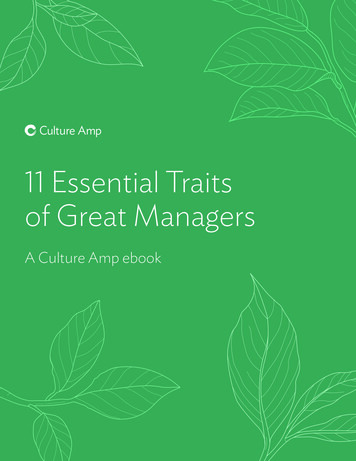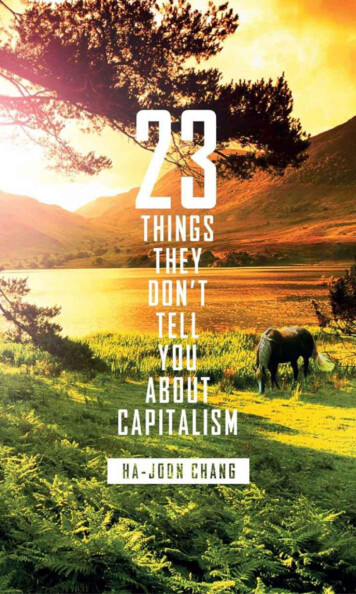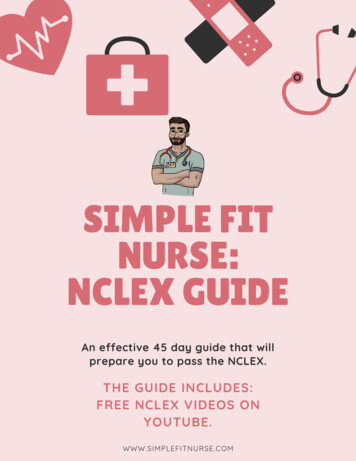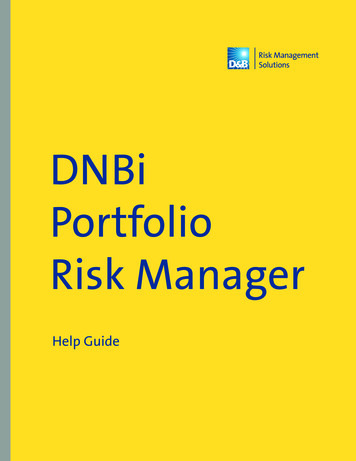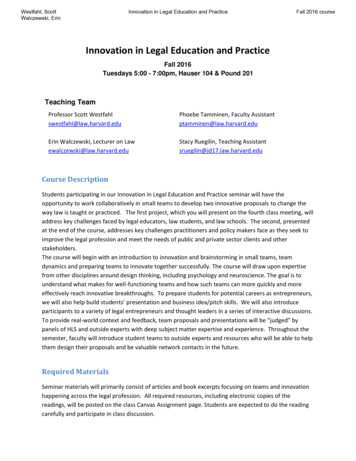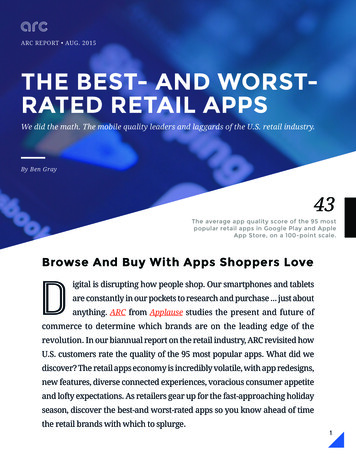
Transcription
For: CustomerExperienceProfessionalsThe Best And Worst Of Mobile UserExperienceby Deanna Laufer, April 4, 2014Key TakeawaysValue, Efficiency, And Presentation Are Key Attributes Of Mobile UserExperienceApp stores now offer close to a million smartphone apps. Leading mobile userexperiences elevate themselves above the competition by delivering clear value,optimizing efficiency, and simplifying presentation.Rethink Current Design Paradigms To Deliver Better Mobile ExperiencesBring clarity and purpose to your mobile user experience by appointing a mobilechampion, carving out time for experimentation beyond stated customer preferences,and iterating with frequent prototypes and updates.Forrester Research, Inc., 60 Acorn Park Drive, Cambridge, MA 02140 USATel: 1 617.613.6000 Fax: 1 617.613.5000 www.forrester.com
For Customer Experience ProfessionalsApril 4, 2014The Best And Worst Of Mobile User Experienceby Deanna Lauferwith John Dalton and Curt NicholsWhy Read This ReportMobile presents an enormous opportunity to transform the customer experiences for those able to copewith relentless device permutations, demanding human factors, and expectant customers. Those willingto make the investment are well-advised to understand what sets the best mobile user experiences apart.This report explores those attributes that are fundamental to the best smartphone app user experiencesand elucidates where the worst go wrong. Further, this report reveals key tactics customer experienceprofessionals can use to turn their web-focused businesses into mobile-excelling organizations.Table Of ContentsNotes & Resources2 Mobile User Experience: It’s ComplicatedForrester interviewed 20 user and vendorcompanies, including BillGuard, Citigroup,KPMG, Duolingo, EffectiveUI, Facebook,Fueled, Hey, Inc., Hollr, Human FactorsInternational, Intuit, Mobients, Mobiquity,Pearson, SapientNitro, Southwest Airlines,T3, Tack Mobile, Walgreens, and Zite.But The Opportunities Are Huge6 Examining The Current State Of Mobile UserExperience7 The Best Are Truly A Breed ApartDeliver Clear ValueOptimize EfficiencySimplify PresentationrecommendationsRelated Research DocumentsMobile Moments Transform CustomerExperienceJanuary 24, 201423 Break Free Of Dated Paradigms To DeliverBetter Mobile ExperiencesGetting Mobile Right With Mobility POSTMay 24, 201325 Supplemental MaterialMobile Feast Or Beggar’s Banquet?January 24, 2013 2014, Forrester Research, Inc. All rights reserved. Unauthorized reproduction is strictly prohibited. Information is based on best availableresources. Opinions reflect judgment at the time and are subject to change. Forrester , Technographics , Forrester Wave, RoleView, TechRadar,and Total Economic Impact are trademarks of Forrester Research, Inc. All other trademarks are the property of their respective companies. Topurchase reprints of this document, please email clientsupport@forrester.com. For additional information, go to www.forrester.com.
For Customer Experience Professionals2The Best And Worst Of Mobile User ExperienceMobile User Experience: It’s ComplicatedMobile may be a diminutive platform, but that doesn’t mean it’s a diminutive experience. Mobile is ahuge step forward in human-centered design, providing a more natural user interface, the flexibility ofcustomizable experiences, and the power of dynamic, real-time feedback (see Figure 1). However, it isprecisely this individualized, always-on experience that breeds myriad complexities that in turn makeachieving a great mobile user experience difficult (see Figure 2). Some of these complexities include: Relentless device permutations. Mobile engagement has to be able to handle spotty networks,dropped connections, and long pauses between service requests across the half dozen mobilenetworks in the US and many more worldwide.1 In addition, moving from Web to mobilemeans growing the range of platforms to be supported from two or three browsers to amultitude of handset types running Android, iOS, or Windows on three- to six-inch screens,with retina, HD, and full HD displays, portrait and landscape modes, and optional keyboards. Demanding human factors. Mobile relies on powerful, yet immature interfaces includingtouch, gesture, motion, and voice. Designers and developers will need to make decisions aboutwhich of the 20 speech recognition application programming interfaces to integrate and howgestures and motion translate differently to the varying operating systems. Physical limitationsplace constraints on the placement and size of touch targets: People should be able to navigatewith one finger or thumb and access targets at least 1 cm square.2 Evolving customer needs. Users engage their smartphones anywhere and everywhere: at home,at work, in stores, outside, and while traveling, commuting, and shopping (see Figure 3). Peoplenow count on their phones to provide unprecedented access to ordinary tasks, like payingbills, to on-the-go tasks, like checking flight schedules and researching restaurants, to relativelynew functions, like controlling home appliances.3 Even within a single app, customers expectto complete a specific journey, like purchasing a product, or use it as a conduit to influenceconsumer interactions with other touchpoints.4 Burdensome ecosystems. Mobile apps don’t exist in a vacuum; they will need to integrate withinternal and third-party data, some of which may run on outdated systems that don’t supportthe pace or volume of mobile interactions. For example, enabling Walgreens customers toorder prescription refills by mobile device required integration with its internal prescriptionsystem, which wasn’t even built for web capability. The same app also required integration witha third party that hosts its coupon experience and another third party that hosts its weeklyadvertisement. As traffic grows, servers and infrastructure will need to be upgraded to copewith the exploding activity volume mobile can deliver.5 2014, Forrester Research, Inc. Reproduction ProhibitedApril 4, 2014
For Customer Experience Professionals3The Best And Worst Of Mobile User ExperienceFigure 1 Mobile Is A Step Forward In User Interface EvolutionMainframeDesktopNone: dumbHigh:green-screendrag-and-drop,Interactivityor command-line point-and-clickterminalsHigh: resizableNone:components,Personalization no customization configurablepossibledisplay, local data,custom shortcutsMedium: real-timeNone: onlycomputation,complicatedPower displays datasent by serverinformationvisualization115703 2014, Forrester Research, Inc. Reproduction -drop,point-and-clickLow:point-and-click,form fill-inHigh: resizablecomponents,configurabledisplay, serverside dataHigh: real-timecomputationcoupled withaccess to serverside dataHigh:Medium: someconfigurablecustomization of screens, personalpage appearance data, customshortcutsNone: onlydisplays datasent by serverHigh: fluidgestures, visualand voice inputHigh:real-time,contextualcomputationSource: Forrester Research, Inc.April 4, 2014
For Customer Experience Professionals4The Best And Worst Of Mobile User ExperienceFigure 2 Mobile ComplexitiesContextNetworkDeviceUser interface10:10 AM Screen Keyboard Sensors OS Software Capabilities115703 2014, Forrester Research, Inc. Reproduction Prohibited Speed Reliability Coverage Services Pricing Task Goals Activity Location Environment Economic status CultureSource: Forrester Research, Inc.April 4, 2014
For Customer Experience Professionals5The Best And Worst Of Mobile User ExperienceFigure 3 Where Smartphone Users Access The InternetLiving roomSchoolLibrary 29%OtherWorkCoffee %BedroomKitchen51%Smartphone50% Bathroom53%Home31% office63%68%Car63%60%In tePublic transitBase: 28,686 US online adults (18 ) who personallyuse a smartphone to go online weekly or moreSource: North American Technographics Online Benchmark Survey (Part 1), 2013115703Source: Forrester Research, Inc.But The Opportunities Are HugeDespite these complexities, a well-designed mobile experience is well worth the effort because: Mobile transforms customer experiences. Want to read product reviews while in a store?Deposit a check-in under a minute while at home or on the go? Track in real time how far awaya car is that is about to pick you up? Mobile redefines what it means to provide useful, easy, andenjoyable experiences by redefining what it means to meet people’s needs, making it even easierand faster for customers to complete tasks and achieve their goals and delighting customers byreplacing previously tedious or painful experiences with brand new experiences.6 The mobile market is still growing. In 2014, global mobile phone accounts are expected tosurpass the number of humans worldwide.7 And for the majority in the US, mobile phonenow means smartphone.8 Smartphone adoption is still higher among younger generations, butForrester predicts that the number of US smartphone users will continue to grow by about 2014, Forrester Research, Inc. Reproduction ProhibitedApril 4, 2014
For Customer Experience Professionals6The Best And Worst Of Mobile User Experience7% a year over the next several years.9 Even though mobile commerce still makes up a smallpercentage of total sales, mobile customers are valuable to your entire business.10 For example,Walgreens found that customers who use both mobile devices and shop in store spend fourtimes what store-only customers do.11 Mobile drives billion-dollar enterprises. Mobile apps for checking the weather, socialnetworking, playing games, and listening to music dominate mobile usage (see Figure 4). Butdon’t fool yourself: Mobile is big business. Instagram, the hugely popular app for taking andsharing photos, launched in October 2010. Less than 2 years later, it was sold for 1 billion.12Uber, an app for requesting private car service is now disrupting traditional taxi services inmore than 26 countries and 60 cities worldwide.13 It was recently valued by investors at around 3.5 billion.14 Airbnb, which has booked stays for over 11 million guests in hosts’ private rooms,apartments, castles, igloos, and tree houses, sees over 37% of its traffic from mobile devices.15Figure 4 Top 10 Mobile App CategoriesCategories of applications used on a smartphone in the past month:Weather65%Social 20%Base: 31,719 US online adults (18 ) who personally use a smartphoneSource: North American Technographics Online Benchmark Survey (Part 1), 2013115703Source: Forrester Research, Inc.Examining The Current State Of Mobile User ExperienceThe Apple iTunes and Google Play stores each offer close to a millions apps, but on average,smartphone users only actively use around 12.16 What do successful companies with millions ofengaged users like Instagram, Uber, and Airbnb have in common? To find out, we: Focused on smartphone apps. Not only do consumers spend more time on their mobileapps than on mobile Web, but apps provide richer, more engaging experiences.17 We focused 2014, Forrester Research, Inc. Reproduction ProhibitedApril 4, 2014
For Customer Experience Professionals7The Best And Worst Of Mobile User Experiencespecifically on smartphone apps, not tablet apps, because customers use tablets differently thanphones and tablet use is still lagging behind that of smartphones.18 We only included Androidand iOS apps in our evaluation because they still dominate consumer usage.19 Tried to accomplish relevant customer goals. We included apps that span the range of themost popular activities, including those for weather, social networking, music, news, shopping,and finance. We attempted to complete common customer journeys applicable to the app’s type,such as checking the weather, reading the news/social updates, sharing a photo, browsing andchecking out of a retail app, and signing in and checking an account balance. Performed head to head comparisons. Using established usability criteria for ease of use,reliability, functionality, and value, we looked for the most compelling examples of mobile userexperience design.The Best Are Truly A Breed ApartWe found that leading mobile user experiences: Deliver clear value. The best mobile experiences provide their users with immediate value,from the second they download and open the application. Throughout the experience theyprioritize core functionality relevant to need and perform reliably. The worst experiences arebogged down with unnecessary content and fail to deliver experiences at moments of need. Optimize efficiency. Mobile use is characterized by short bursts of partial attention throughoutthe day. To meet mobile users’ needs, the best experiences enable quick and easy navigation,even while distracted. The worst experiences leave users wondering what they were doing andhow much longer or how many more steps is this going to take. Simplify presentation. Screen real estate is at a premium on mobile devices. The best experiencescapitalize on this constraint by focusing the customer’s attention on visual, engaging content ratherthan clunky, desktop-era controls. The worst experiences are cluttered with text, icons and labels.Deliver Clear ValueCustomers aren’t going to use an app that doesn’t provide them value.20 And because mobilecustomers expect to get what they want in the moment, the best mobile user experiences must: Demonstrate immediate value for the customer. In its first one and a half months, the iPhoneapp Heyday assembled half a million customers. Heyday knew that most people learn aboutapps from others, so it set out to engage customers from their first interaction. The app collectsphotos from a user’s phone and assembles them into a timeline, chronicling where they’ve beenand what they’ve seen and shows this history right from the first interaction (see Figure 5). In 2014, Forrester Research, Inc. Reproduction ProhibitedApril 4, 2014
For Customer Experience Professionals8The Best And Worst Of Mobile User Experiencecontrast, Friday, another storyline app, shows an empty timeline when first downloaded, forcingusers to work first before enjoying the experience. Similarly, Fancy, which prides itself on lettingits users discover and buy crowd-curated goods, requires users to sign in before being ablebrowse and uncover the value of the app (see Figure 6). Prioritize core functionality. Shazam, the hugely popular music identification app with over420 million global users includes features that allow users to explore what other users arelistening to by geographic location; browse the top hits; discover what friends are listeningto; share via Facebook, Twitter, Google , WhatsApp, or Pinterest; download songs via iTunes,Google Play, or Amazon.com; stream on Rdio or Spotify; and look up song lyrics. But youwouldn’t know if from the app’s home screen, which enables users to identify songs with oneeasy tap (see Figure 7). Likewise, Fab, an eCommerce shopping site, sees over a third of its salesfrom mobile devices and at least partially credits its success on fewer things distracting usersfrom buying.21 Contrast this to Macy’s mobile app, which doesn’t feature an “add to bag” buttonprominently and instead requires users to scroll down to find it (see Figure 8). Incorporate content relevant to user’s context. 7-Eleven’s app offers users deals that arerelevant to the current weather and time of day and are available at the nearest 7-Eleven store.On a cold winter night, 7-Eleven suggests that its customers warm up with some hot chocolate(see Figure 9). Not only is this more useful to the customer, but businesses benefit too. T3 foundthat for its clients, targeted offers like these perform 40% better than regular offers. Contrast thiswith Fandango’s app which doesn’t take into account time of day or movie genre preferenceswhen displaying movie listings. Perform reliably and smoothly. Mobile users have little patience for slow loading or crashingapps and will only retry apps once or twice.22 That’s why mobile performance needs to be bothsnappy and stable. Good performance also means fast, fluid experiences instead of waitingfor choppy website-like reloads. The team behind the 5-star rated Duolingo app spent about aquarter of its time to making sure its performance and animations are fast and smooth. Contrastthis to Hilton Worldwide’s HHonors app, which stalls when trying to access a user’s location andotherwise inches along with the all-to-familiar “Loading . . . please wait” as it searches for hotels,displays the detail of a hotel, and loads the checkout process. Capital One’s ShareBuilder appfailed to even load each of the four times which we tried to download and launch it. 2014, Forrester Research, Inc. Reproduction ProhibitedApril 4, 2014
For Customer Experience Professionals9The Best And Worst Of Mobile User ExperienceFigure 5 Heyday Begins Chronicling Your Life, From The Moment Of DownloadSource: Heyday mobile app115703 2014, Forrester Research, Inc. Reproduction ProhibitedSource: Forrester Research, Inc.April 4, 2014
For Customer Experience Professionals10The Best And Worst Of Mobile User ExperienceFigure 6 Fancy And Friday Don’t Provide Immediate Value To UsersFancy sidelines users with required login.Friday starts users with an empty timeline.Source: Fancy mobile app and Friday mobile app115703 2014, Forrester Research, Inc. Reproduction ProhibitedSource: Forrester Research, Inc.April 4, 2014
For Customer Experience ProfessionalsThe Best And Worst Of Mobile User Experience11Figure 7 Shazam Home Screen: Simply Touch To ShazamSource: Shazam mobile app115703 2014, Forrester Research, Inc. Reproduction ProhibitedSource: Forrester Research, Inc.April 4, 2014
For Customer Experience Professionals12The Best And Worst Of Mobile User ExperienceFigure 8 Product Pages From Fab And Macy’sFab’s streamlinedproduct listing andproduct informationpages guidecustomers to browseitems and add to cart.Macy’s product pagehas four lines of texttaking up real estateand doesn’t feature theadd to bag buttonprominently.Source: Fab mobile app and Macy’s mobile app115703 2014, Forrester Research, Inc. Reproduction ProhibitedSource: Forrester Research, Inc.April 4, 2014
For Customer Experience Professionals13The Best And Worst Of Mobile User ExperienceFigure 9 7-Eleven Suggests Offers Relevant To Location, Weather, And Time Of DaySource: 7-Eleven mobile app115703Source: Forrester Research, Inc.Optimize EfficiencyPeople now spend equal amounts of time online on their phones as on their PCs, but in morefrequent, shorter increments, and with only partial attention.23 Successful mobile apps recognizethese behaviors and seamlessly guide users in and out of interactions. The best experiences: Go fast. Uber’s car service app lets customers request a car, at their location, in two taps (seeFigure 10). Key to the immediacy of this service is that the app stores your payment information,so you don’t need to enter it when you request a car or fumble with cash in a cab. Forrester hassimilarly found that successful mobile retail companies, like Amazon.com, eBay, and Grouponalso preserve customers’ payment and shipping information, allowing quick checkout.24Cumbersome processes and tasks, such as searching for products and checking out, are likelyto derail users. Browsing for a tablet on Best Buy’s mobile app requires navigating through fivescreens before a sortable list is presented (see Figure 11). 2014, Forrester Research, Inc. Reproduction ProhibitedApril 4, 2014
For Customer Experience Professionals14The Best And Worst Of Mobile User Experience Support easy navigation. Instagram supports over 150 million users sharing an average of55 million photos daily.25 One if its founders credit its success with one key characteristic: itssimplicity.26 The app effortlessly guides users through the process of taking a photo, filtering,tagging, and sharing (see Figure 12). Complex tasks risk frustrating users. First time customersbuying an item on Staples’ (home of the easy button) app will find themselves winding in and outof an anchor screen and at least five other screens before they can place an order (see Figure 13). Minimize input. Forcing customers to type on small screens is a losing proposition. HomeDepot’s app bypasses these obstacles by allowing customers to search for products one of threeways: by typing in keywords, using voice recognition, or scanning a barcode. Similarly, Grubhuballows users to take a picture of their credit card instead of typing the information. BillGuard, aniPhone finance app, has over half a million users and is adding 3,000 new users daily. It reportsabove average weekly customer engagement for its industry, thanks in part to its sign in processwhich requires a simple 4-digit pin instead of a user name and lengthy password (see Figure 14).What does bad mobile user input look like? Tiny fields, lengthy forms, and text-only input. Enable persistence. Zappos’ mobile app supports customers that want to explore productsand purchase them, but not necessarily in one interaction. Browsing for boots? If customersput away their phones and then return hours later, the app will remember where they were andlet them continue their search right where they left off. Similarly, Netflix and Amazon Kindlesupport non-continuous viewing and reading, respectively, both on phones and other devices.Conversely, Target’s app launches customers into their app’s home screen, regardless of theirprior activity, leaving them to retrace their steps or abandon their task completely. 2014, Forrester Research, Inc. Reproduction ProhibitedApril 4, 2014
For Customer Experience Professionals15The Best And Worst Of Mobile User ExperienceFigure 10 Uber’s Two-Step Process For Requesting A CarStep 1: Select pickup location.Step 2: Request car.Source: Uber mobile app115703 2014, Forrester Research, Inc. Reproduction ProhibitedSource: Forrester Research, Inc.April 4, 2014
For Customer Experience ProfessionalsThe Best And Worst Of Mobile User Experience16Figure 11 Best Buy’s App Requires Navigating Through Three Layers Of Categories Before BrowsingSource: Best Buy mobile app115703 2014, Forrester Research, Inc. Reproduction ProhibitedSource: Forrester Research, Inc.April 4, 2014
For Customer Experience Professionals17The Best And Worst Of Mobile User ExperienceFigure 12 Instagram Guides Users Through The Process Of Sharing PhotosIn each ofInstagram’s steps fortaking and sharing aphoto, it highlightsthe next task in blue,so users know wherethey’re going next.Source: Instagram mobile app115703 2014, Forrester Research, Inc. Reproduction ProhibitedSource: Forrester Research, Inc.April 4, 2014
For Customer Experience Professionals18The Best And Worst Of Mobile User ExperienceFigure 13 Checking Out With Staples’ Mobile App Is An Exercise In PatienceJust a handful of themany screens guestsmust navigate tocheck out on Staples’mobile app. Staplesrequires duplicateinformation(confirming an emailaddress, not shown)and redundantinformation that theapp could infer itself,such as the city andstate from the zipcode, and the creditcard type from thenumber.Source: Staples mobile app115703 2014, Forrester Research, Inc. Reproduction ProhibitedSource: Forrester Research, Inc.April 4, 2014
For Customer Experience Professionals19The Best And Worst Of Mobile User ExperienceFigure 14 Signing Onto BillGuard Requires Only A 4-Digit PinSource: BillGuard mobile app115703Source: Forrester Research, Inc.Simplify PresentationWeb pages typically include numerous icons, labels, text, and scroll bars; but designers don’t have theluxury of 15-inch screens on mobile devices. To simplify presentation, the best mobile experiences: Focus on content, not chrome. Whether its four inches or five, mobile screen real estate is at apremium. When Heyday designed its app, it didn’t want to take up space or disrupt the aestheticsof the experience with cumbersome desktop controls, so it emphasized content. Save for the searchbar on top, the entire rest of the screen is devoted to displaying the user’s timeline. Similarly, thehome screen on Airbnb’s app includes only one menu bar at the top, devoting the remainder ofthe screen to users scrolling and swiping through gorgeous photos of potential rentals (see Figure15). Contrast that with Macy’s mobile app, which instead of featuring additional items or largerpictures for easy browsing, wastes five lines of space on controls, text, and icons. 2014, Forrester Research, Inc. Reproduction ProhibitedApril 4, 2014
For Customer Experience Professionals20The Best And Worst Of Mobile User Experience Rely on intuitive touch gestures. When BillGuard started as a web app, its customers werehappy, but not engaging on a regular basis. So when it decided to launch a mobile app, itdesigned the functionality such that reviewing and approving a charge could be accomplishedwith just a swipe of the thumb (see Figure 16). This simple, intuitive design made the chore ofreviewing bills fun, and helped increase BillGuard’s user base tenfold. Similarly, popular newsreading app Flipboard uses simple gestures to refresh content, flip up and down between newsstories, and swipe left to return to the home screen, leading users to proclaim they are “addictedto the flip.” Contrast this to Toys“R”Us’ app, which relies on gratuitous controls instead of simpleswipe gestures (see Figure 17). Minimize labels and icons. Facebook’s new Paper app currently has an app store ratinghigher than Facebook’s itself. Its designers strove to enable users to experience its content,not the technology or software. To that end, it minimized many of the labels found onFacebook’s primary app, such as the like, comment, and share text, while maintaining the samefunctionality via familiar icons (see Figure 18).Figure 15 Heyday, Airbnb, And Solar Embed Controls Within Their ContentSource: Heyday mobile app, Airbnb mobile app, and Solar mobile app115703 2014, Forrester Research, Inc. Reproduction ProhibitedSource: Forrester Research, Inc.April 4, 2014
For Customer Experience Professionals21The Best And Worst Of Mobile User ExperienceFigure 16 BillGuard Uses The Swipe Gesture To Make Reviewing Credit Card Bills FunThe BillGuard app lays out all of a user’s new charges, has the user swipe the charge to the right to clear it,and then signals the user when done reviewing.Source: BillGuard mobile app115703 2014, Forrester Research, Inc. Reproduction ProhibitedSource: Forrester Research, Inc.April 4, 2014
For Customer Experience ProfessionalsThe Best And Worst Of Mobile User Experience22Figure 17 Toys“R”Us’ App Relies On Gratuitous ControlsSource: toysrus mobile app115703 2014, Forrester Research, Inc. Reproduction ProhibitedSource: Forrester Research, Inc.April 4, 2014
For Customer Experience Professionals23The Best And Worst Of Mobile User ExperienceFigure 18 Paper Represents A Clean, New Experience For Facebook CustomersReading the same post on Facebook’s Paper app (left) and original app (right)Source: Facebook Paper mobile app115703Source: Forrester Research, Inc.R e c o m m e n d at i o n sBreak Free Of Dated Paradigms To Deliver Better Mobile ExperiencesMany of the best mobile experiences we highlight — Instagram, Uber, Heyday, and Shazam —started in mobile. This is no accident. Startups have the advantage of beginning with a clean slateand building distinctive mobile experiences. Customer experience professionals at companiesaugmenting their legacy businesses will need to rethink their old web-driven design paradigms andelevate their mobile experiences by employing these tactics: Appoint a decision-maker. An ecosystem with too many diffuse stakeholders slows downdevelopment, incurs redundant investments, and produces bloated or uncoordinatedexperiences.27 One design and development agency told us that for some of their lesssuccessful projects, every time they want to change the color of a button they need approvalfrom 30 people. A single decision-maker can be accountable for integrating functionalityacross organizational silos and keeping development moving forward. 2014, Forrester Research, Inc. Reproduction ProhibitedApril 4, 2014
For Customer Experience Professionals24The Best And Worst Of Mobile User Experience Partition mobile teams at the outset. It may seem counter-intuitive to silo mobiledevelopment from other digital channels, but just as bad as diffuse leadership is a webfocused organization intent on miniaturizing for mobile. When a division of Pearson, theworld’s largest education company, decided to wet its feet with mobile, it formed a newskunk works-like mobile team and paired with design and development agency Tack Mobileto create its OpenClass app. Breaking out mobile separately allowed Pearson to keep a freshapproach, complete major redesigns in under a year, and then gradually socialize mobileinto the culture at Pearson. Intuit starts with a central mobile-focused group that bears theinvestment risk, and then hands off responsibility to business units once momentum andexpertise for mobile has been institutionalized. Make time for experimentation. Mobile interfaces are still not well understood, whichmeans customers, and even most companies, don’t know what they need or want froma mobile experience. Instead, startups and mobile-focused design agencies advise takingrisks by experimenting with what’s possible with mobile before settling on a defined mobilestrategy. Lead designer of the top-rated weather app Solar aimed to “flip weather on its head”and played around with various method of interaction before landing on its color-driven,chrome-free design. Lead designer of the Facebook app Paper said
For Customer experienCe proFessionals the Best and Worst of mobile user experience 2 2014, Forre
